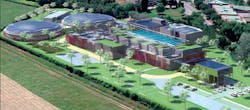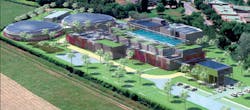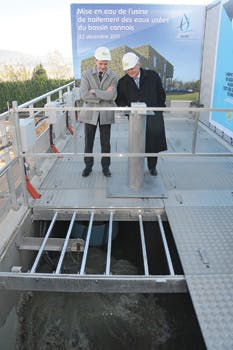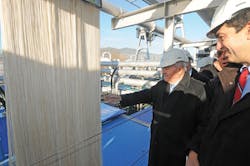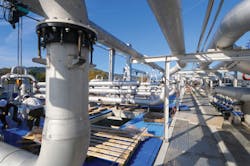Carbon Neutral Wastewater Treatment? A Cannes-Do Approach in the Cote d'Azur
Wastewater. Carbon Neutrality. The two don't usually go together but the world's first Aquaviva facility in France started operating fully recently and is proving this is an option. Jeremy Josephs looks at the technology behind these claims and whether such an alleged eco-friendly approach could be replicated internationally.
If you play the time-honoured game of random association, so favoured by Freud and his army of followers, and throw in the word 'Cannes', what responses might you generate? Sun-kissed beaches? The Promenade de la Croissette? The city's glitzy annual film festival? Certainly all three would be likely to loom large on any list.
Now, many people might will say that 'the world's first carbon-neutral wastewater treatment plant' seems an unlikely candidate for inclusion - and besides, the phrase doesn't exactly flow from the tongue. But if Bernard Brochand, the city's Mayor, has anything to do with it, all of that is about to change. For he has embraced a notion - which he describes as industrial or technical tourism - with an almost evangelical fever of which even the most ardent ecologist would be rightly proud.
"Does this mean that people are going to ditch the beach and spend their time to come and visit our beautiful new Aquaviva facility?", he enquires rhetorically. "Certainly not. But I can tell you one thing, they might very well end up spending some time on both."
Together with Yann Rolland, deputy CEO of Lyonnaise des Eaux, the dynamic duo have been unveiling their dream in incremental phases - the plant only becoming fully operational a month or so ago.
The Aquaviva facility is indeed a world first in terms of its carbon-neutrality, its treatment processes based on membrane technology, and is so efficient in its design and conception that there are no greenhouse gas emissions whatsoever.
This is achieved through a series of ambitious and innovative technical firsts, including the introduction of bacteria to remove pollutants such as phosphorous and centrifugation to dispose of sludge.
Designed to treat up to 88,000 m3 per hour and serving a population of around 300,000 the building also happens to be quite beautiful, covered with vegetal walls and harmoniously integrated into the already luscious landscape of the Cote d'Azur.
"Nor is this a pilot project", Rolland is eager to point out. "It can be rolled out at other sites on a similar scale or, more importantly, without waiting to evaluate the performance of this facility. The plant can be duplicated immediately. Consequently, as part of its new engagement for 2012-2016, Lyonnaise des Eaux will neutralize the greenhouse gas emissions of 10 new facilities by 2016."
Rolland adds how the Aquaviva project has helped raise the bar when it comes to environmental protection.
"Controlling greenhouse gas emissions has become a key environmental concern for local authorities," he says. "Initially emission control was done on a proactive basis but since the completion of the Aquaviva project, it has become a statutory requirement: under the Grenelle II Act, local communities in France with more than 50,000 inhabitants are now legally required to produce climate and energy plans for their communities.
"There is thus huge potential for sanitation services to play their part in reducing greenhouse gas emissions in local communities. They can employ processes related to their business lines (for instance, recovering organic material) or set up additional sources of renewable energy at their facilities, such as solar panels.
Improving local water quality
The deputy CEO adds: "Here at Lyonnaise des Eaux we began offering local authorities the possibility of building carbon neutral facilities as early as 2008. So when the call for tenders was issued at the end of 2007, we wanted to help tackle the climate and energy problems faced by the Greater Cannes area, in particular those expressed in the city's quality of life "Agenda 21".
At the time, climate and energy were already key environmental concerns for the local authorities, on a par with the concern for water quality. The quality of treated effluent was also a priority, given the susceptibility of the receiving water and the fact that it was used for bathing. And we also had to bear in mind that the size of the site meant that any facility had to be compact."
If all of this comes across as somewhat cosy and complacent - this was not always the case in the city of Cannes. In fact, if truth be told, there was something quite rotten just a stone's throw from the Aquaviva plant itself, in the heart of the French Riviera.
"Yes, that's right", Brochand confirms rather matter-of-factly. "My predecessor Michel Mouillot was corrupt - he served six and half years in prison - and it was clearly important for me to wipe the slate, and by that I mean his tainted slate, clean. I had to review many things and getting a state-of-the-art wastewater treatment plant was high on my list of priorities."
One understandable outcome of all of this was that the tender process for the Aquaviva plant had to be whiter-than-white. Transparency was the watchword, with Suez winning hands down because of their "experience, their technical competence and, of course, the most amazing design", says the Mayor.
Eight municipalities signed up for and became connected to Aquaviva via hundreds of miles of wastewater collection and transportation connections: Auribeau sur Siagne, Cannes, Le Cannet, Mandelieu, Mouans-Sartoux, Pégomas, La Roquette sur Siagne and Théoule, meaning that Acquaviva will henceforth be receiving 15 million m3 of effluent per year.
A key feature of the plant is no less than 4000 square meters of energy producing solar panels. This involved the supply of one thousand photovoltaic units supplied by the Pégomas-based company Tournaire Solaire Energie. Equally important is the wastewater treatment sludge which is dried on site and then packaged to be used as natural fertilizer or fuel as "efficient as wood".
The combination of all of these elements has been to ensure that the plant has become a flagship for sustainable development because of its ability to successfully blend together three distinct elements - the latest technical specifications, co-integration and an alluring design which is so successful that the plant already looks as if it positively belongs to the Riviera.
Environmental remuneration
Being involved in such a stylish carbon-neutrality initiative from the outset of the plant's development has clearly meant that Lyonnaise des Eaux was able to showcase Cannes' determination to safeguard the environment. A feather in the cap for Lyonnaise? Undoubtedly.
But it has been a win-win situation for the city of Cannes too which is now able to benefit from a modern plant in which there is no discharge of suspended solids, a facility that meets the sustainable development requirements of a low-consumption building requiring no interior heating and very high-quality output water which is discharged into the Bay of Cannes.
Rolland is keen to emphasise that the plant is not the end but just the beginning of its ongoing sustainable development policy. "Lyonnaise des Eaux also wants to develop the offer to local authorities of a contract that formalises our commitment to local sustainable development through the stipulation that a portion of our remuneration will be based on achieving quantitative environmental goals, such as water resource protection, greenhouse gas emission reductions and biodiversity conservation. Remuneration linked to environmental performance is already included in about a dozen Lyonnaise des Eaux contracts in France and can account for up to 15% of our revenue.
"Innovation and progress have always been part of the "genetic code" of Lyonnaise des Eaux, which has always been forward thinking so as to anticipate and protect against risks to water quality and, more broadly, the environment. Under the banner "Innovate to produce healthy water and measure its effectiveness", and as part of our new sustainable development engagement for 2012-2016, we are committed to saving even more water, doing what we can to restore good environmental status, reducing - and even offsetting - the pressure on biodiversity, and gradually transforming our treatment facilities into environmental platforms."
Ultrafiltration
Now if all of that is in danger of sounding like a party political broadcast for the Lyonnaise des Eaux party, well, the proof of the pudding is in the plant itself. The key to Aquaviva is its use of ultrafiltration modules as well as a membrane bio-reactor.
The treatment process also enables effluent to be re-used for watering green spaces and for the cleaning of both the streets of Cannes and its environs too. In fact its purification efficiency far exceeds regulatory requirements. The plant even managed to come in on its original budget of €77 million.
The facility's operation will be audited by a certification organization in order to attain the ISO 14001 environmental management standard. The bottom line of all of this is that the new WWTP has succeeded in completely neutralizing greenhouse gas emissions. Greenhouse gases will make up only 269 equivalent tons of carbon annually - that is to say 90% less than the previous plant. But these emissions are now being completely offset.
The technology was developed by Degrémont, a subsidiary of Suez Environnement, which specifies and uses a variety of equipment and material. It's not without some justification, therefore, that both Brochand and Rolland are in crowing mode.
A lot of commentators, both local and national, were skeptical as to whether or not the project would find its way to completion at all. Of whether or not it would in fact achieve what it had set out to achieve.
"My tendencies lie with the right, not the left, as you would expect from someone with my political background", the Mayor of Cannes concludes.
"But I have to confess that I was more than a little impressed with the way Barack Obama campaigned and ended up by being elected as president of the United States of America. Well, I would like to take a leaf out of his book - or at least out of his campaigning book. To those who doubted as to whether or not we could pull this off, and produce the first carbon neutral wastewater treatment plant in the world - I would always give the same answer. 'Can we do this here on the Cote d'Azur?', people would often enquire? And to which I would always reply with just three words - 'Yes, we Cannes.'
